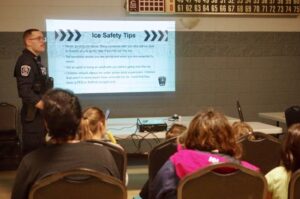Fort William First Nation’s Employment and Training and Family Program hosts ice safety presentation

By Rick Garrick
FORT WILLIAM FIRST NATION — Fort William First Nation’s Employment and Training and Family Program staff held an Ice Safety presentation by Nishnawbe Aski Police Service Constable Mason Morriseau on Jan. 13 at the Fort William First Nation Community Centre.
“Whenever you go on the ice, you want to make sure that you have somebody with you because if you fall in the (water) you want somebody to go and get help,” says Morriseau, a Fort William citizen. “When you go on the ice, you want to tell somebody or bring an adult with you before you go on the ice so that somebody knows that you’re going.”
Morriseau says they recommend that parents put a lifejacket on their children if they are going on the ice.
“When you go on a boat, do you wear a lifejacket?” Morriseau asks. “It’s the same thing, when you’re walking on ice, you want to wear a lifejacket because what happens if you go through the ice? You’re in the water.”
Morriseau also stressed the importance of carrying ice picks when going on the ice.
“They’re used for rescuing yourself out of ice water,” Morriseau says. “If you fall in the water, you can use those ice picks to dig yourself out of the water, and then you can use ice cleats so you don’t slide and fall.”
Morriseau says one rule is do not go on river ice.
“If you see a little river or a stream, don’t go onto the river ice,” Morriseau says. “The rivers are always moving, there’s water going through the rivers. You don’t want to step on the ice because you might not know how thick it is and you can fall in the water.”
Morriseau says another rule is do not go on the ice when it starts getting warmer out and there is water on top of the ice.
“You don’t want to go on the ice when there’s water on top of the ice because that can mean the ice is breaking up and it won’t be able to hold your weight, you might fall through the ice,” Morriseau says. “So don’t go onto the ice when it gets a little warmer out if you see water on top or if the ice is starting to melt on the shore.”
Morriseau also shared a minimum ice thickness chart for clear ice for different uses.
“You never want to go on the ice if it’s less than four inches of ice depth,” Morriseau says. “If you put a vehicle on the ice, it’s usually 12-15 inches so that’s pretty deep to hold all that weight.”
Morriseau also spoke about what to do if you break through the ice.
“When you go into the ice water, it’s going to be super cold,” Morriseau says. “What you want to do is put out your arms to try to stop yourself from going under the water. If you go into super cold water, you might breathe in water … so you put your arms out so you can sort of stop yourself. Make sure you hold your mouth closed so you don’t get water in your mouth.”
Morriseau says to call for help if you fall into the water.
“You want to keep as calm as possible because you need to conserve all your energy so you can get out,” Morriseau says. “You want to put your hands on top of the ice, pull your upper body up on top of the ice so your legs are kind of still in the water and you’re going to kick like you’re swimming until your body is up above the ice. And then what you’re going to do is you’re going to roll.”
Morriseau says to avoid standing up right away after getting out of the water because the ice could break again.
“When you get your body up, you’re just going to roll a couple of feet the same way that you came in,” Morriseau says. “If you see footsteps, you’re going to follow the same way you came in because you know you didn’t fall through that way. They also say that once you roll, if you roll a decent amount away you can crawl.”
Morriseau adds that people need to get warm after getting out of the water, so they need to change into dry clothes and drink something warm.
“You want to warm yourself up slowly — don’t warm yourself up too warm,” Morriseau says. “You want to increase your body temperature slowly.”
Morriseau says it is important to call 911 for help if you see someone falling through the ice.
“You want to tell them where the person is,” Morriseau says. “From the nearest fire station, it takes 18 minutes for a fire truck to get out to Sq… Bay (in Fort William).”


